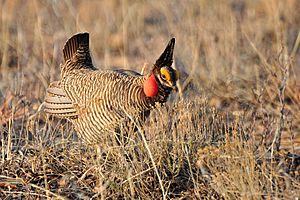Lesser prairie-chicken facts for kids
Quick facts for kids Lesser prairie-chicken |
|
|---|---|
 |
|
| A lesser prairie chicken in New Mexico | |
| Conservation status | |
| Scientific classification | |
| Genus: |
Tympanuchus
|
| Species: |
pallidicinctus
|
 |
|
| Lesser prairie-chicken range. | |
| Synonyms | |
|
Tympanuchus cupido pallidicinctus |
|
The lesser prairie-chicken (Tympanuchus pallidicinctus) is a special type of bird that belongs to the grouse family. It's known for living in the wide-open spaces of North America. This bird is facing challenges, and many people are working to protect it.
Contents
What Does the Lesser Prairie-Chicken Look Like?
This bird is a medium-sized grouse. It has stripes of white and brown feathers. It is a bit smaller and lighter in color than its close relative, the greater prairie-chicken. Adult lesser prairie-chickens are usually about 15 to 16 inches (38 to 41 cm) long. They weigh between 22 and 29 ounces (620 to 820 grams).
Where Do Lesser Prairie-Chickens Live?
About half of the lesser prairie-chicken population lives in western Kansas. The other half lives in the sandhills and prairies. These areas include western Oklahoma, the Texas Panhandle, eastern New Mexico, and southeastern Colorado.
How Do Lesser Prairie-Chickens Behave?
Like its larger relatives, the lesser prairie-chicken is famous for its unique lekking behavior. During the spring, male birds gather in open areas called "leks." They perform special dances and make booming sounds. This display is to attract female birds for mating. It's a very important part of their life cycle.
Why Are Lesser Prairie-Chickens Vulnerable?
The IUCN (International Union for Conservation of Nature) lists the lesser prairie-chicken as "vulnerable." This means the species is at risk of becoming endangered. The main reason for this is habitat destruction. Their natural home has shrunk by about 85%. In some areas, their numbers have dropped by as much as 99%. This is because their prairie and sandhill homes are being changed.
Scientists also think that global warming might harm the birds. It could reduce the size of the sagebrush areas they need to survive.
Protecting the Lesser Prairie-Chicken
Protecting this bird has been a big topic. On March 27, 2014, the lesser prairie-chicken was listed as "threatened" under the Endangered Species Act. This law helps protect animals and plants that are in danger. However, this listing was later removed after a legal challenge.
In 2021, the United States Fish and Wildlife Service (USFWS) suggested a new plan. They proposed splitting the species into two groups. The northern group (in Oklahoma, Colorado, Kansas, and part of Texas) would be listed as "threatened." The southern group (in New Mexico and part of Texas) would be listed as "endangered."
On November 17, 2022, the USFWS made this official. The southern group became "endangered," and the northern group became "threatened." This rule officially started on March 27, 2023.
Political Discussions About Protection
The listing of the lesser prairie-chicken has led to many discussions. In 2015, Senator Jerry Moran from Kansas tried to change the listing. He wanted to overturn the protection for the bird. He felt it was too much government involvement in private land and businesses.
The U.S. Senate voted on a bill that included this change. However, it did not get enough votes to pass.
In May 2023, the Senate voted again to remove the bird's new protection. This was done using a special process called the Congressional Review Act. President Joe Biden said he would not sign the bill if it passed. The House of Representatives did pass the bill on July 27. But President Biden vetoed it on September 27, 2023. This means the bird's protections remained in place.
See also
 In Spanish: Gallo de las praderas chico para niños
In Spanish: Gallo de las praderas chico para niños


